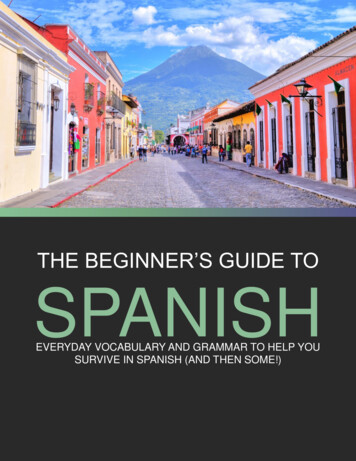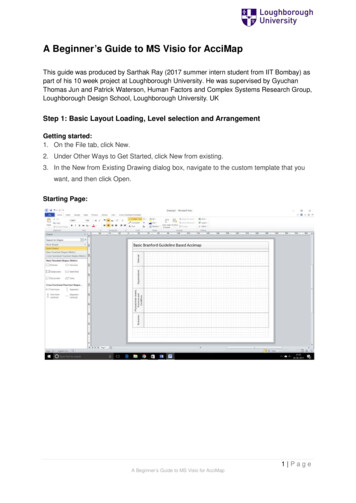
Transcription
THE BEGINNER’S GUIDE TOSPANISHEVERYDAY VOCABULARY AND GRAMMAR TO HELP YOUSURVIVE IN SPANISH (AND THEN SOME!)
TABLE OF CONTENTSCHAPTER 1GreetingsCHAPTER 2Personal PronounsCHAPTER 3Definite and Indefinite ArticlesCHAPTER 4Verb ConjugationCHAPTER 5Stem-changing VerbsCHAPTER 6Numbers 1-100CHAPTER 7Ser vs. EstarCHAPTER 8NegationCHAPTER 9Asking Questions
CHAPTER ONEGREETINGS
GREETINGSWhile you may know “hola”, there are a number of other common Spanishgreetings. Spanish speakers use different greetings depending on the time ofday, including:Buenos días (good morning)Buenas tardes (good afternoon)Buenas noches (good evening/good night)Note: You can also say “Buenas” or “muy buenas” a shortened version ofthe above three greetings, suitable in any informal situation.There are, of course, other ways of greeting someone. Formal greetings use theformal form “usted”, including:¿Cómo está usted? (How are you?)¿Cómo le va? (How’s it going?)¿Qué hace? (What are you doing?)Informal greetings use the informal form “tu”, including:¿Cómo estás? (Hello, how are you?)¿Cómo te va? (How’s it going?)¿Qué haces? (What are you doing?)Another extremely common informal greeting is ¿Qué tal? which roughly means“What’s up?”Common responses to these questions include:Bien, gracias. / Muy bien. (Well, thanks. / Very well.)Como siempre. (As always.)Más o menos. (Okay, so-so.)Todo bien. (All good, great.)Nada. (Nothing.)When meeting someone for the first time, you can say “mucho gusto” (nice tomeet you) or “encantado/encantada” (how do you do).
GREETINGSWhen leaving somewhere, you can use the same expressions to saygoodbye as you used to say hello, given the time of day:Buenos días (good morning)Buenas tardes (good afternoon)Buenas noches (good evening/good night)Other common ways to say goodbye include:Adiós (Bye)Hasta luego/hasta más tarde (See you later)Hasta mañana (See you tomorrow)Hasta pronto (See you soon)Hasta la próxima (Until next time)Hasta ahora (See you in a minute)Nos vemos. (See you soon/ See ya)A few more formal ways to end a conversation or phone call include:Que tenga un buen día. (Have a nice day!)Encantada de haberle visto. (Pleased to have seen you.)Practice pronouncing these greetings and morewith this video from the Transparent SpanishYouTube channel.
CHAPTER TWOPERSONAL PRONOUNS
PERSONAL PRONOUNSPERSONAL PRONOUNSYoITúYou (singular, informal)UstedYou (singular, formal)Él/EllaHe/SheNosotrosWeUstedesYou (plural)Ellos/EllasThey (masculine/feminine)Spanish personal pronouns serve the same purpose as in English, but they canbe a bit trickier for a few reasons.First, many speakers do not use personal pronouns in spoken Spanish. This isbecause the verb conjugation will identify the subject. A pronoun is usually onlyused when referring to a third person (he, she, or they). As you get morefamiliar with verb conjugations (which we’ll cover in this eBook), you’ll find thisless confusing.
PERSONAL PRONOUNSSecond, Spanish uses different forms of address depending on the levelformality required:Tú -- Use tú with friends, peers, children, and people younger than you.Usted – Use usted with your boss, people older than you, or any adults you donot know.Third, Spanish pronouns vary based on location. In the table above, we’vegiven the most common Latin American pronouns. But in Spain, “vosotros” isused for the plural, informal “you.”Then there’s the confusing concept of “voseo”. In theSouthern Cone (Argentina, Uruguay, and Paraguary) and someparts of Central America, “vos” is used as the single “you”.Learn more about the rules dictating the Spanish “voseo” inthis blog post.
CHAPTER THREEDEFINITE & INDEFINITEARTICLES
DEFINITE & INDEFINITEARTICLESDEFINITE ARTICLESIn English, when referring to a specific object, we use one article: the. (The cats,the bottle, the sky, etc.) In Spanish, there are four ways to say the:PERSONAL PRONOUNSElMasculine, singularLaFeminine, singularLosMasculine, pluralLasFeminine, pluralWe can see these pronouns in action when describing a dog:El pero (the male dog)Los perros (the male dogs)La perra (the female dog)Las perras (the female dogs)In those examples, it’s pretty obvious when to use the masculine or femininepronoun—depending on the gender of the dog. But all Spanish nouns havegender, whether it’s an animate object or not. Unfortunately, there’s no rulegoverning noun gender—it’s just something you have to memorize.Examples:El vestido (the dress) “Dress” may seem like a feminine noun, but it’smasculine.La corbata (the tie) Again, “tie” might seem like a masculine noun, butit’s feminine.
DEFINITE & INDEFINITEARTICLESINDEFINITE ARTICLESIn English, when referring to a unspecified object, we use a, an, or some . (aflower, an apple, some cupcakes, etc.) In Spanish, there are four ways to say the:PERSONAL PRONOUNSUnMasculine, singularUnaFeminine, singularUnosMasculine, pluralUnasFeminine, pluralWe can see these pronouns in action when describing a dog:Un pero (a male dog)Unos perros (some male dogs)Una perra (a female dog)Unas perras (some female dogs)Examples:Un sombrero (a hat)Unos lápices (some pencils)Una puerta (a door)Unas manzanas (some apples)Learn more about noun gender in Spanish inthis quick grammar video.
CHAPTER FOURVERB CONJUGATIONS
VERB CONJUGATIONS-AR VERBSThe first group of verbs, known as –ar verbs, includes verbs that end in –ar, suchas trabajar (to work), hablar (to talk), and mirar (to look at). To conjugate –arverbs, drop the –ar from the end of the verb (this forms the “root”) and appendthe correct conjugation suffix. The suffix changes depending on the subjectperforming the verb, so it’s important to memorizing these endings.Verbs ending in –ar are conjugated using the following Note: Usted (you) used the same conjugation as él/ella (he/she), NOT tú. Same goesfor ustedes using the same conjugation as ellos/ellas.**Note: Remember, vosotros is only used in Spain.Trabajar (to work)Yo trabajoTú trabajasÉl/Ella/Usted trabajaNosotros trabajamosVosotros trabajàisEllos/Ellas trabajanHablar (to speak)Yo habloTú hablaasÉl/Ella/Usted hablaNosotros hablamosVosotros hablàisEllos/Ellas haban
VERB CONJUGATIONS-ER VERBSThe second group of verbs, known as –er verbs, includes verbs that end in –er,such as comprender (to understand) or correr (to run). To conjugate –er verbs,drop the –er and add the following Note: Usted (you) used the same conjugation as él/ella (he/she), NOT tú. Samegoes for ustedes using the same conjugation as ellos/ellas.**Note: Remember, vosotros is only used in Spain.Comprender (to understand)Yo comprendoTú comprendesÉl/Ella/Usted comprendeNosotros comprendemosVosotros comprendéisEllos/Ellas comprendenCorrer (to run)Yo corroTú corresÉl/Ella/Usted correNosotros corremosVosotros corréisEllos/Ellas corren
VERB CONJUGATIONS-IR VERBSThe third group of verbs, known as –ir verbs, includes verbs that end in –ir, suchas vivir (to live) or escribir (to write). To conjugate –ir verbs, drop the –ir andadd the same endings are –er verbs (with the exception of vosotros, for theCastilian Spanish learners among *-ísÉl/Ella/Usted*-eEllos/Ellas/Ustedes-en*Note: Usted (you) used the same conjugation as él/ella (he/she), NOT tú.Same goes for ustedes using the same conjugation as ellos/ellas.**Note: Remember, vosotros is only used in Spain.Vivir (to live)Yo vivoNosotros vivemosTú vivesVosotros vivéisÉl/Ella/Usted comprende Ellos/Ellas vivenAs you can see, the different verb endings indicate the subject of the sentence—”vivo” indicates that the subject is “I”, because it ends in “o”. That’s why manySpanish speakers drop the personal pronouns. More often than not, you’ll hear:Escribo. (I write.)Trabajas. (You work.)Ella habla. (She speaks.)*Partemos. (We leave.)Vivéis. (You live.)Ellos corren. (They run.)**Note: You should still use the pronoun in the third person, unlessyou’ve already determined who you’re talking about.
CHAPTER FIVESTEM-CHANGINGVERBS
STEM-CHANGING VERBSWe hate the be the bearer of bad news, but the last chapter was a bit of anover-simplification of conjugation Spanish verbs. There are many exceptions inthe form of stem-changing verbs, or verbs whose stems change whenconjugated in the present. You’ll want to memorize the following rules to helpyou manage the exceptions.1.e ie verbsIn some verbs, “e” becomes “ie” in the stem when conjugated, except in thenosotros and vosotros forms.Example: empezar (to begin)Yo empiezoTú empiezasÉl/ella/usted empiezaNosotros(as) empezamos*Vosotros(as) empezáis*Ellos, ellas, ustedes empiezanThe following verbs are all “e ie” verbs:advertir (to warn)apretar (to tighten)atender (to pay attention)atravesar (to go through)calentar (to heat)cerrar (to close)comenzar (to start)concertar (to set a date)confesar (to confess)convertir (to convert)defender (to defend)despertarse (to wake up)digerir (to digest)divertirse (to have fun)encender (to light)entender (to understand)extender (to stretch)herir(to hurt)hervir (to boil)mentir (to lie)negar (to deny)pensar (to think)perder (to lose)preferir (to prefer)querer (to want)sentarse (to sit)sentirse (to feel)sugerir (to suggest)temblar (to tremble)tender (to spread out)transferir (to transfer)tropezar (to stumble)
STEM-CHANGING VERBS2. o ue verbsIn some verbs, “o” becomes “ue” in the stem when conjugated, except in thenosotros and vosotros forms.Example: almorzar (to have lunch)Yo almuerzoTú almuerzasÉl/ella/usted almuerzaNosotros(as) almorzamosVosotros(as) almorzáisEllos/ellas/ustedes almuerzanThe following verbs are all “o ue” verbs:acordar(se) (to remember)acostar(se) (to lie down, to go to bed)apostar (to bet)colgar (to hang)comprobar (to confirm)contar (to tell, to count)desenvolver (to unwrap)devolver (to give back)doler (to hurt)dormir (to sleep)encontrar(se) (to meet, to find)envolver (to wrap)forzar (to force)morder (to bite)morir (to die)mostrar (to show)mover (to move)poder (to be able to)probar (to try)recordar (to remember)resolver (to solve)rodar (to roll)soler (to be used to)soltar (to let go, to release)soñar (to dream)volar (to fly)volver (to come back)
STEM-CHANGING VERBS3. e i verbsIn some verbs, “e” becomes “i” in the stem when conjugated, except in thenosotros and vosotros forms.Example: pedir (to ask)Yo pidoTú pidesÉl/ella/usted pideNosotros(as) pedimosVosotros(as) pedísEllos/ellas/ustedes pidenThe following verbs are all “e i” verbs:competir (to compete)impedir (to stop)rendir (to produce, yield)servir (to serve)vestir(se) (to (get) dressed)despedir (to say goodbye)medir (to measure)repetir (to repeat)teñir (to dye)
STEM-CHANGING VERBS4. c zc verbsIn some verbs, “c” becomes “zc” in the stem when conjugated, but ONLY in thefirst person “yo” form.Example: parecer (to seem)Yo parezcoTú parecesÉl/ella/usted pareceNosotros(as) parecemosVosotros(as) parecéisEllos/ellas/ustedes parecenThe following verbs are all “c cz” verbs:abastecer [to supply]agradecer [to thank]amanecer [to dawn]anochecer [to get dark]aparecer [to appear]conducir [to drive]conocer [to know, to meet]crecer [to grow]deducir [to deduce]empobrecer [to make poor]enriquecer [to get rich]envejecer [to age]establecer [to establish]fallecer [to pass away]favorecer [to favor]fortalecer [to strengthen]inducir [to induce]introducir [to insert]merecer [to deserve]nacer [to be born]obedecer [to obey]ofrecer [to offer]permanecer [to remain]pertenecer [to belong]producir [to produce]reducir [to reduce]rejuvenecer [to rejuvenate]seducir [to seduce]traducir [to translate]
STEM-CHANGING VERBSThere are other irregular verbs that change in the present tense for pronunciationpurposes. The verbs keep the same sound but add or change a letter:Ending: -carSpelling change: C for QUBefore: EExample: buscar – busqué, busqueEnding: -ger, -girSpelling change: G for JBefore: A/OExample: recoger – reocojo, recoja;Ending: -garSpelling change: C for GUBefore: EExample: entregar – entregué, entregueEnding: -guirSpelling change: deletion of UBefore: A/OExample: conseguir – consigo, consigaEnding: -zarSpelling change: Z for CBefore: EExample: utilizar – utulicé – utiliceEnding: -quirSpelling change: QU for CBefore: A/OExample: delinquir – delinco, delincaEnding: -cer, -cirSpelling change: C for ZBefore: A/OExample: vencer – venzo, venza
CHAPTER SIXNUMBERS 1-100
NUMBERS intePractice pronouncing these numbers withour video on Spanish Numbers 1-20.
NUMBERS 1-100After 20, the numbers follow a formula. Memorize the numerals often (twenty, thirty, etc.), then add the single digits to form biggernumbers.For example, twenty is veinte. So twenty-one is veintiuno, twenty-twois veintidós, etc.Starting from 30 upwards, use “y” to combine the tens place with thedigit. For example, thirty is treinta, so thirty-one is treinta y rtyFiftySixtySeventyEightyNinetyOne hundred*When we use the number 100 in isolation we call it “cien” butwhen it is combined with other units or tens (from 101 to 199), thenit canges to “ciento” as in “ciento uno” (101).
CHAPTER SEVENSER VS. ESTAR
SER VS ESTAROne challenge for Spanish learners is distinguishing when to use ser or estar,both of which translate into “to be” in English. But first, let’s start with theirconjugations:SER (to stedesEllos/Ellas/UstedessonESTAR (to ly, ser is used with adjectives expressing permanent characteristics,including nationality, physical appearance and personality.On the other hand, estar is used with temporary states or conditions, such asemotions.Example:El café es caliente. (Coffee is hot.)In this case, use ser because coffee is usually hot.Los cafés están fríos. (The coffees are cold.)In this case, use estar because the coffees were hot but have become cold,which is not their normal condition.
SER VS ESTARWHEN TO USE SER Origin or NationalitySoy de Honduras. (I am from Honduras.) OccupationÉl es un bombero. (He is a firefighter.) PossessionEs mi pero. (It’s my dog.) Telling Time* and PlaceEs la una. (It is 1:00.)Son las dos. (It is 2:00.)La fiesta es a su casa. (The party is at her house.) Essential Characteristics**El libro es largo. (The book is long.)Ella es rubia. (She is blonde.)La salsa es picante. (Salsa is spicy.)Tú eres muy joven. (You are very young.)*Note: When telling time, 1:00 uses the third personal singular (es), while allother times using the third person plural (son.)**Note: Essential characteristics may not be permanent, but they describe thenature of the subject rather than describing the subject at a given moment. Forexample, the subject of the sentence “you are very young” will not be youngforever, but for many years to come, he or she will be considered young.
SER VS ESTARWHEN TO USE ESTAR Temporary State or ConditionEstoy enferma. (I am sick.)Estamos perdidos. (We are lost.)No estoy casado. (I am not married.) EmotionsEstás muy triste hoy. (You are very sad today.) LocationNo estan en casa. (They are not at home.)Note that your choice of ser or estar can change the meaning of a sentence:Elena está aburrida.Elena is bored.Elena es aburrida.Elena is boring.Marco está cansado.Marco is tired.Correr un maratón es cansado.Running a marathon is tiring.La manzana está verde.The apple is unripeLas manzanas Granny Smith son verdes. Granny Smith apples are green.¿Estás listo para ir al cine?Are you ready to go to the movies?Ese niño es muy listo.That little boy is very clever.
CHAPTER EIGHTNEGATION
NEGATIONThere are many ways to negate a sentence in Spanish.The most common negation involves simply placing “no” before the verb.María no conoce a Carlos. (Maria does not know Carlos.)No tengo bastante tiempo. (I don’t have enough time.)Beyond “no”, there are other common negative words:Nadie (nobody, no one)Nada (nothing, not anything)Ningúno, Ningúna* (none, not any)Nunca (never)Ni ni (neither nor )Tampoco (neither, not either)*Note: Ningúno changes to “ningún” before masculine singular nouns.These words can be used alone before the verb, just like “no”.Nadie habla español aquí. (Nobody speaks Spanish here.)Nada puede detenerme. (Nothing can stop me.)Nunca bebo leche. (I never drink milk.)
NEGATIONIn Spanish double and even triple negatives are allowed and, in many cases,necessary.No hay nadie aqui. (No one is here.)No tiene ninguna esperanza. (He doesn’t have any hope.)No lo se. Ella no lo sabe tampoco. (I don’t know. She doesn’t know either.)If you use this double negative construction, any words that follow must benegative. For example, in English, we would say “I don’t have anything.” But inSpanish, you must say “I don’t have nothing.”No tenemos nada. - We don’t have anything. (literally nothing)
CHAPTER NINEASKING QUESTIONS
ASKING QUESTIONSQuestion WordsQuéWhatPor énWhoCuánto(a)How muchCuántos(as)How manyTo ask a question in Spanish, place one of the question words above at the beginningof the sentence. Note that Spanish questions begin with an inverted question mark.Examples:¿Qué estás diciendo? [What are you saying?]¿Por qué ella se fue tan temprano? [Why did she leave so early?]¿Cuándo vas a darme la respuesta? [When are you going to give me theanswer?]¿Dónde te vas a quedar en tus vacaciones? [Where are you going to stay duringyour vacation?]¿Cómo estás? [How are you?]¿Cuál tren debo tomar? [Which train do I take?]¿Quién quiere ir conmigo? [Who wants to go with me?]¿Cuánto tiempo necesitas para hacer eso? [How much time do you need to dothat?]¿Cuántos libros tenemos que comprar? [How many books do we have to buy?]
ASKING QUESTIONSFor simple yes or no questions, you don’t even need a question word. Aninverted question mark will indicate a question in writing, while intonation iskey to indicating a question in spoken Spanish. Raise the pitch of your voicethe same way you would when asking a question in English. For example:She’s pregnant.She’s pregnant? Emphasizing the end of the sentence turns it into aquestion.Word order in yes or no questions is flexible. For example, both of thefollowing questions mean the same thing: Does she speak English?¿Ella habla ingles?¿Habla ella ingles?If you’re worried about your intonation, you can also indicate you’re asking aquestion by added some kind of question statement at the end.Ella habla ingles, ¿no? (She speaks English, doesn’t she?)Ella habla ingles, ¿verdad? (She speaks English, right?)
over-simplification of conjugation Spanish verbs. There are many exceptions in the form of stem-changing verbs, or verbs whose stems change when conjugated in the present. You’ll want to memorize the following rules to help you manage the exceptions. 1.e ie verbs In some verbs, “e











